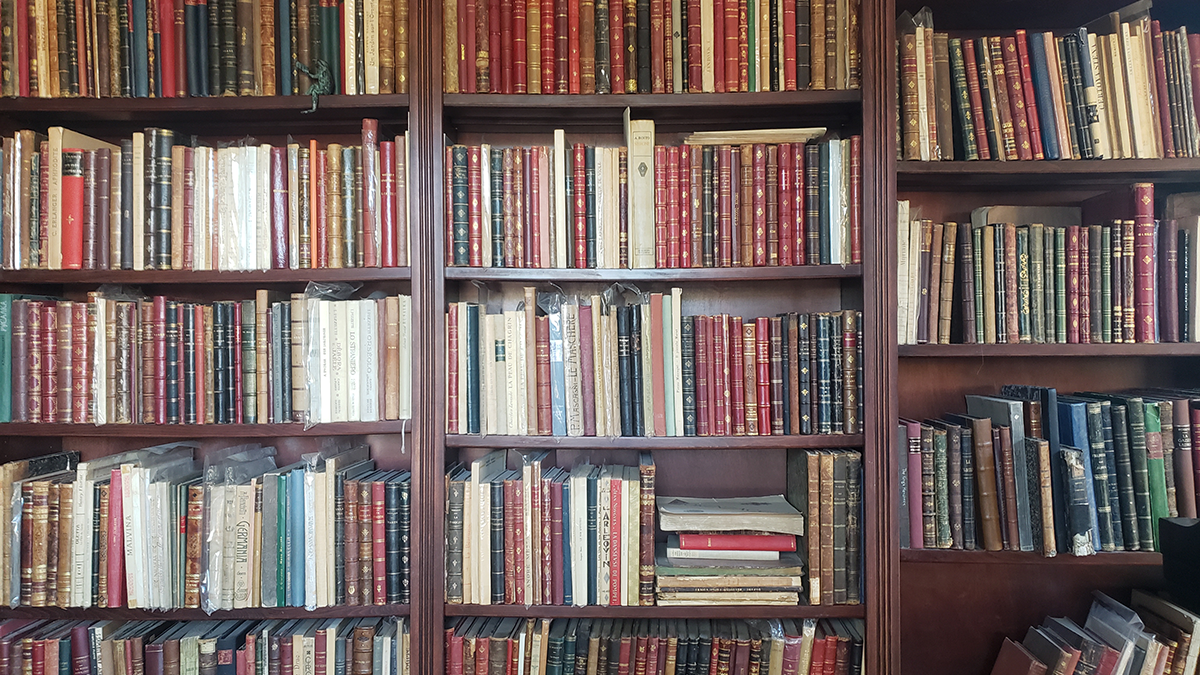Music professor’s private collection of old music books and opera scores preserves history

Robert Mills' opera scores and old music books.
Robert Mills, clinical associate professor in the School of Music, Dance and Theatre and vocal coach/accompanist for Music Theatre and Opera, is passionate about old music books and opera scores. A collector for almost 20 years, he has amassed a private collection that now numbers between 750-800 first- or early-edition scores.
“Most of the scores I own are from the 19th to early 20th century,” said Mills. “The only people that could afford the scores back then were wealthy people, so the books were leather bound with intricate artwork. It's not economical to print those types of books anymore. I think of them as a piece of art because the books themselves are intrinsically beautiful. I started collecting and have not stopped.”
He estimates 70–80% of the scores are first editions, with the remaining 30% being second or early editions.
The Music Library in the School of Music, Dance and Theatre is currently hosting “With the Flow of the Hand,” an exhibit from his private collection featuring 11 signed opera scores by Wagner, Rossini, Verdi, Massenet, Puccini, Poulenc, Hahn, Thomas, Saint-Saëns and Gounod. The exhibit runs through Dec. 20.
Mills became interested in collecting scores while pursuing his DMA in collaborative piano at ASU in the early 2000s when his mentor, Professor Eckart Sellheim, invited students to his residence for an event. Mills said he was fascinated by Sellheim’s vast collection of rare and beautiful music books and scores.
As a student with very limited funds, he started collecting little works here and there. Soon, collecting became his passion.
Mills said he used to travel to Europe frequently for music programs and would shop in small music stores or secondhand bookstores. Since he does not travel as much, he now finds books and scores mostly online or through international art and book dealers.
Mills said he was amazed at the scores he found in secondhand bookstores, including several he considers “diamonds in the rough” because they are very rare or difficult to find. Because music was not most bookshop owners’ specialty, they often did not know the true value of old music books.
Because he has been collecting for so long, Mills said he has learned what is valuable and oftentimes finds books for as little as $10.
For library exhibits, Mills said he devises a topic or theme and then selects the scores to match. Then, he and Linda Elsasser, the Music Library’s learning services manager, organizes and installs the exhibit.
The topic for the current exhibit, “With the Flow of the Hand,” is signed opera scores. All of the scores in the exhibit are signed, some of which are dated and include inscriptions.
In the beginning, Mills said everything was fascinating, so he collected almost anything because he was building his collection. Now, he looks primarily for signed scores or scores with important provenance.
The exhibit includes a signed first-edition score of the opera “Das Rheingold” by Richard Wagner, the 19th-century German composer. The inscription says “Adieu, Adieu” but does not say to whom it is addressed. Mills said he believes the score was given as a gift to Mathilde Wesendonck, a19th-century German poet who had an affair with Wagner, as her name is written in the front of the book.
Christopher Mehrens, librarian and musicologist, said the Music Library has hosted exhibits featuring scores from Mill’s collection since 2008, including “With the Flow of the Hand, Composers Make their Mark,” signed scores by Jules Massenet, Reynaldo Hahn, Aaron Copland and Giuseppe Verdi; “The Making of a Myth: Greek and Roman Manifestations,” 19th- and 20th-century scores of mythological characters, events and places; and “It’s a Thin Line: Deception, Crimes of Passion, and Glorious Agony in Verismo Opera,” featuring Giacomo Puccini, Ruggero Leoncavallo, Umberto Giordano, Pietro Mascagni and Gustave Charpentier in addition to a few others.
The Music Library also has featured exhibits on special items from its collections and some by ASU collectors and curators, including “Something to Dance About!” featuring former musical theater faculty member JoAnn Yeoman Tongret’s Madame Alexander ballet dolls; “Treasures From the Collection of Eckart and Dian Sellheim,” an extensive collection of rare piano scores of Sellheim, professor emeritus and director of collaborative piano, and his wife, internationally renowned concert pianist Dian Baker; and most recently, a dance exhibit by Adair Landborn, ASU dance faculty and curator of the Cross-Cultural Dance Resources Collections.
The Music Library, on the third floor of the Music Building’s west wing, is well known for the vast collections of books, scores, recordings, videos, periodicals and special collections that assist with music research.
“Each of my predecessors have been integral to the development the ASU Music Library collections, and I have been privileged to build on their foundational work,” said Mehrens.
More Arts, humanities and education

ASU professor's project helps students learn complex topics
One of Arizona State University’s top professors is using her signature research project to improve how college students learn…

Award-winning playwright shares her scriptwriting process with ASU students
Actions speak louder than words. That’s why award-winning playwright Y York is workshopping her latest play, "Becoming…

Exceeding great expectations in downtown Mesa
Anyone visiting downtown Mesa over the past couple of years has a lot to rave about: The bevy of restaurants, unique local shops…

